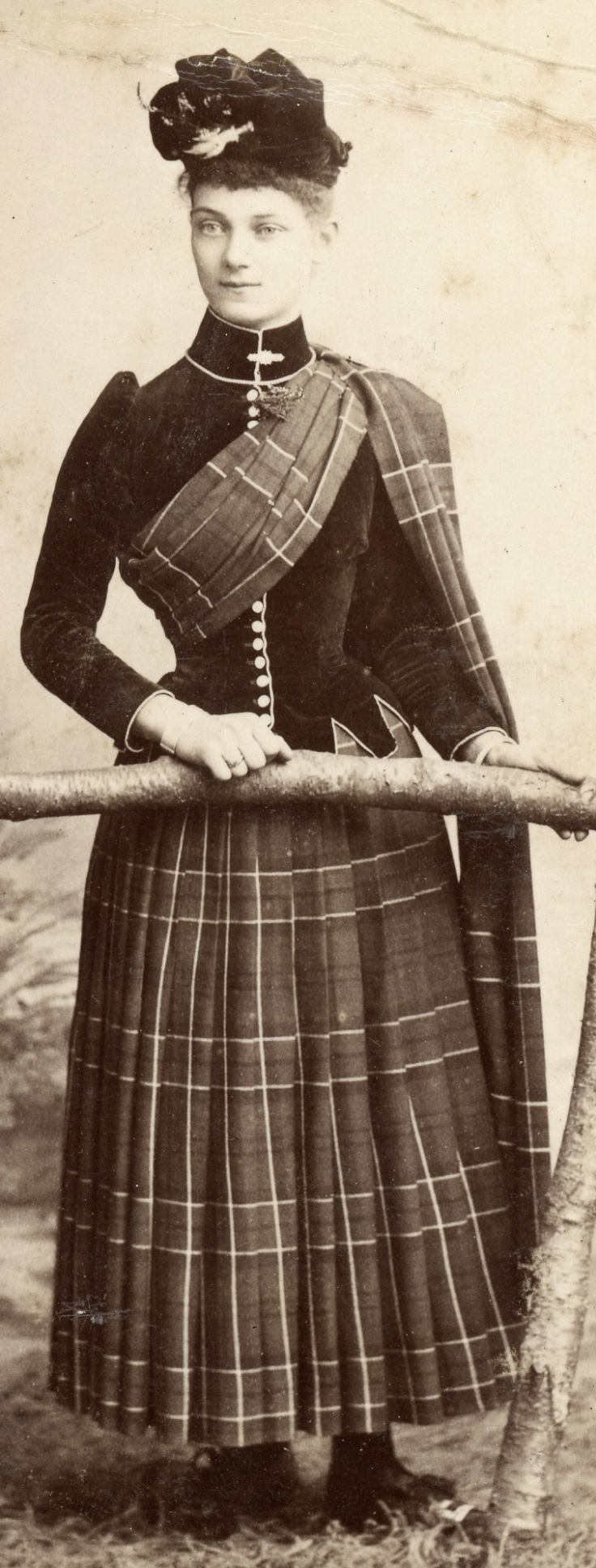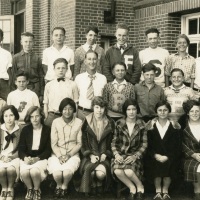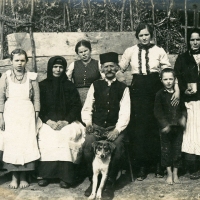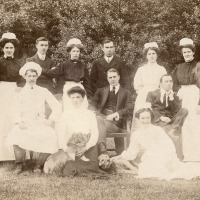This cabinet card portrait was made at the studio of Sweet & Kinloch in Rothesay, on the Isle of Bute (“N.B.” refers to North Britain). A genealogy of the Sweet Family in the West of Scotland identifies one of the studio owners as Charles Sweet (1864-1945). Born in Glasgow, Charles opened his studio in Rothesay in 1889 with a younger partner, Charles R. Kinloch, who was originally from there (born about 1868, according to the 1891 Scotland Census). In 1893 the two parted ways, with Kinloch moving to Glasgow.

According to the 1881 Scotland Census, Kate Sharp was also born in Glasgow. In 1881 she was eleven years old and living in Rothesay with her parents, John and Janet Sharp, and her little sister Mary. John was born in Rothesay, while Janet was born in nearby Cowal, Argyll. In 1881, John’s age is listed as 28 and Janet’s as 25, meaning that when Kate was born, her father was about 17 and her mother was about 14. John’s occupation is listed as “Draper & Clothier.”
I was unable to track Kate in census records after 1881. According to a handwritten annotation on the front of the card, Kate’s portrait was made in 1890, when she was about 20 years old. Charles Sweet, her likely photographer, was about 26.


On a personal note, Sweet is a name in my own family tree. One of my great-great-grandmothers was named Henrietta Laura Augusta Sweet. She was born in 1841 in New Cumberland, Pennsylvania, which is near the state capital of Harrisburg. Her great-grandfather, Dr. Caleb Sweet, was a surgeon in the Continental Army during the American Revolutionary War.






It´s lovely! Thank you for sharing 🙂
LikeLiked by 1 person
Thank you, Annica. 🙂
LikeLiked by 1 person
Such a charming photo! I love her tartan skirt. I wonder if her Dad made it. Maybe she is a long-lost relative of yours. 🙂
LikeLiked by 2 people
Sorry, typo. I meant “he”, the photographer. 🙂
LikeLiked by 1 person
If he’s a relative, it’s a very distant connection. On the other hand, I like the idea that a name can bridge so much distance and time, if only symbolically. 🙂
LikeLiked by 2 people
Oh, and I feel quite certain that her father was involved in the creation of her outfit! He probably had a print of this photo displayed prominently in his shop. 😀
LikeLiked by 2 people
The tartan skirt caught my eye as well. Matching the plaid, particularly with pleats, takes great deal of skills.
LikeLiked by 4 people
That’s the first thing I spotted. I had a knife-pleat skirt in junior high that also was plaid, and I remember my mother muttering a bit as she was making it.
LikeLiked by 2 people
“I remember my mother muttering a bit as she was making it.” That made me smile!
LikeLiked by 1 person
Wonderful portrait.
The thistle at her neck and probably on the front of her toque; a jacket of cotton velvet, perhaps lined but certainly edged with cotton piping;buttons made of bone; that magnificent tartan skirt; and this most imposing fall of a matching scarf (I’m sure that is not what it is called) over her left shoulder slipped throughy a decorative pin. Left shoulder no less! One wonders whether that left has a significance. Unmarried?
Magnificent portrait. Thank you!
LikeLiked by 2 people
Thank you, Sarah! I particularly like her jacket, and the way the velvet texture comes through in the photo. You probably also noticed the ring on her right ring finger. In Scotland, might that have indicated that she was engaged or even married? I’m not sure about the customs at that time.
LikeLiked by 1 person
I sent a wee note to friends on the Isle of Coll to ask what details they can clarify about this lovely portrait.
The tartan over her left shoulder is called a ‘sash’ and that it is on the left denotes that she is married. Which probably also explains the ring. And also brings up questions as to why the left and not the right with this most critical status. But that is a Ph.D. thesis in itself!
The pin on her shoulder is a plaid brooch. Usually in silver with, usually, a cairngorn stone in the middle.
As to the clan affiiliation of this tartan: without colour, my friends said, it is difficult to tell. But the Isle of Bute was owned by the Stuarts of Bute at this date and her father may well have been of that clan………………………Best, Sarah
LikeLiked by 2 people
Thank you for writing to your friends, and for passing along that helpful information! It was very kind of them to look at the photo and offer their thoughts on it. How interesting it must be to live on the Isle of Coll. A place requiring a degree of self-reliance, I expect. Regarding Kate’s ring, we’ll let her keep that secret, for now. 😉
LikeLiked by 1 person
She looks so young! I wonder if she was a redhead, with her light eyes and fair skin.
LikeLiked by 1 person
Great question, Liz. That hadn’t even occurred to me, oddly enough.
LikeLiked by 1 person
For some reason, I was most surprised by her mother’s name. ‘Janet’ sounds 1950s America to me, not late 1800s Scotland. When I took a brief look, though, I read that it’s a medieval diminuitive of ‘Jane.’ That brought Jane Eyre to mind, and things turn a turn toward the understandable!
LikeLiked by 3 people
I didn’t know it was a diminutive of Jane! Now I need a refresher on Jane Eyre, which I read in high school….
LikeLiked by 1 person
Do you have some old photos of your relatives?
LikeLiked by 2 people
I do, but only some of them. Many, like Henrietta Sweet, must have had their portraits made, but my grandparents didn’t inherit them. Do you have any old family photos?
LikeLiked by 2 people
Yes, I have some, not many too. Do you plan to make a story about some of your relatives’ photo?
LikeLiked by 2 people
I’ve thought about it, but probably not anytime soon. Who knows, though, maybe I’ll feel inspired and do one or two. 😉
LikeLiked by 1 person
You do manage to find out a lot of information about all the people involved in this photo – very interesting. 🙂
But That Waist! I am so grateful to live in a time when fashion does not dictate that I cannot breathe! 🙂
LikeLiked by 3 people
I was thinking the same thing about the corset-bound waist!
LikeLiked by 3 people
haha 😀
LikeLiked by 2 people
Her pose is very stiff–understandably!
LikeLiked by 2 people
haha Yes! 😀
LikeLiked by 1 person
Rothesay, N.B. is of course North Bute, but it made me think of Rothesay, New Brunswick! I spent 3 months in Canada in 1990. I remember driving through or past Rothesay, perhaps I even visited, but I have no particular memory of that. The name has stuck in my mind though! Nothing to do with the photo, I admit, only a reminiscence triggered by two letters.
LikeLiked by 2 people
It’s funny that you would say that, because I thought the same thing! Despite the fact that the photo was for sale in Earl Shilton, Leicestershire (England), I assumed it must have been taken in New Brunswick, because of all the Scots in the Maritimes. If not for the Sweet genealogy site, I might still believe it. The real mystery is why Sweet and Kinloch thought anyone would know that N.B. meant North Bute!
LikeLiked by 1 person
I’ve just run across a usage of N.B. to mean North Britain, so I’m going to make a note of that in the text. It was on a photo from Forres, on the Moray coast of Scotland, written Forres, N.B. I searched a bit and found it written in a period document as Forres, North Britain. However, I found no references to Rothesay, North Britain, while North Bute is a common usage.
LikeLiked by 1 person
Interesting photo, Brad. I was curious about the sash and found this: https://www.houseoftartan.co.uk/news/press3.htm So it seems she might have been something to do with a clan chief.
LikeLiked by 2 people
That’s great information, Val, thank you! For the convenience of other readers, here’s what it says about wearing a sash over the left shoulder:
“The sash is worn over the left shoulder, across the right breast and secured with a brooch on the left shoulder. This style is worn by Lady Chiefs, chieftainesses, the wives of clan chiefs and chieftains, and the wives of colonels of Highland regiments.”
LikeLiked by 4 people
You’re welcome.
LikeLike
How interesting! It adds another dimension to the portrait.
LikeLiked by 1 person
Her waist is so tiny!
LikeLiked by 2 people
I know, poor thing!
LikeLiked by 1 person
She’s a beautiful young woman. I love her outfit, although I do think all those buttons on her jacket would be quite a chore.
LikeLiked by 2 people
Good point. I expect it’s not an outfit one would wear often….
LikeLiked by 1 person
What a “Sweet” nod to your own family history. 😊 Kate is a beautiful young woman with a gentle look about her. Her right eyebrow is stronger than her left. I wonder if something happened. Her parents were only children themselves when they had her. I suspect her father was a talented clothier based on her manner of dress. I wish I could see the tartan she wears in color. I imagine it’s beautiful, such strong careful pleats. I wonder if her father made it. The pin on her hat looks rather sword like to me. She has a wonderful softness about her. A lovely share and great research Brad 😊
LikeLiked by 2 people
Thank you so much, Suzanne! The left side of her face (her left) appears faded, perhaps due to a flaw in the development process, which could explain why she appears to have only a partial left eyebrow. You’re absolutely right that her parents were still children when they had her–especially her mother. I should mention that the age recorded in the census is the age at the time the census is taken, but Janet could have been closer to 26 than 25 in 1881, which would mean that she was closer to 15 than 14 when she had Kate (or Kate could have turned 11 just before the census). I’ve tried to find Kate’s parents in other records, in the hope of finding out more, but haven’t succeeded. Sharing a photo like this is great fun for me because readers notice all sorts of things that I don’t. I learn so much, first from the research, then from the knowledge and observations that readers so generously contribute.
LikeLiked by 2 people
I did wonder about that, if it was perhaps something in the age or development of the photograph. It’s funny, I don’t think of Janet as being an especially Scottish name but then I never really thought about it much before. Census records are such wonderful resources when it comes to things like this. 😊
LikeLiked by 2 people
Interesting photo, interesting comments. I don’t know which pinches most, the corseted waist or the idea of being a mother at 14. I also did not know anything about the way that these plaids were worn in Scotland.
LikeLiked by 2 people
Thanks for reading, Andrea! I wonder if 14 was considered an acceptable age to start a family in 1870, or if it was generally frowned upon. It might have depended on the community or even the social class of the parents. Either way, a 14-year-old mother would need a lot of help and support.
LikeLiked by 2 people
How amazing to be able to hear stories of such wonderfully old photos!
LikeLiked by 1 person
In most cases, like this one, I wish I had more to tell! Sometimes I buy a photo with just a name on it, and then find a lot of information online. Then I have to decide whether to focus on the stories or just the photo. Thanks, Jewel! Brad
LikeLiked by 2 people
It must take a lot of time and research. Thank you for allowing us a glimpse into history!
LikeLiked by 2 people